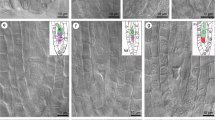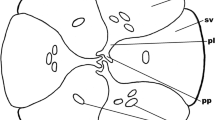Summary
The organs of the flower ofLimnanthemum cristatum Griseb., arise in acropetal succession.
The tapetum of the microsporangium is multi-nucleate and shows nuclear fusion.
The diploid number of the species is determined for the first time as 18 and is confirmed from the results of meiotic counts (n = 9). The pollen grains are three-celled at the shedding time.
The embryo-sac shows integumentary tapetum and a chalazal nutritive tissue. Their role in the economy of the nutrition of the ovule is discussed.
The development of microsporangium inEnicostemma littorale Blume., is normal. The tapetum is uni-nucleate. The haploid chromosome number of this species has been recorded for the first time as nineteen.
The development of embryo-sac and embryo are of the normal type.
Similar content being viewed by others
Literature Cited
Bhaduri, P. N. “The development of ovule and embryo-sac inSolanum melongena L.,”Jour. Ind. Bot. Soc., 1932,11, 202.
— “Studies on the Female Gametophytes in Solanaceæ,” —, 1935,14, 133.
Billings, F. H. “The nutrition of the embryo-sac and embryo in certain Labiateæ,”Kamas. Univ. Sci. Bull., 1909, No. 5.
Fagerlind, F. “Embryologische, zytologische und bestäubungs-experimentelle Studien in der Familie Rubiaceæ nebst Bemarkungen über einige Polyploiditätsprobleme,”Acta. Hort. Berg., 1937,11, 195.
Figdor, W. “UberCotylanthera Bl.,”Ann. Jard. Buitenz., 1897,14, 213 (quoted from Schnarf, 1931).
Gates, R. R. “The behaviour of chromosomes inOenothera lata ×O. gigas,”Bot. Gaz., 1909,22, 129.
Guerin, P. “Sur le sac embryonnaire et en particulier les antipodes des Gentianes,”Journ. de. bot., 1903,17, 101.
— “Le developpement de l’anthere et du pollen chez les Gentianes,”C. R. Acad. Paris, 1924,179, 1620.
— “L’anthere des Gentianees. Developpement du sac polliniques,” —, 1925,180, 852.
— “Le developpement de l’anthere chez les Gentianacees,”Bul. Soc. Bot. France, 1926, 73, 5.
Hofmeister, W. “Neure Beobachtungen über Embryobildung der Phenerogamen,”Jahreb. f. wiss. Bot., 1858,I, 82.
Kausik, S. B. “The life-history ofLobelia trigona Roxb. with special reference to the nutrition of the embryo-sac,”Proc. lnd. Acad. Sci., 1935,2, 410.
Latter, J. “The pollen development inLathyrus odoratus,”Ann. Bot., 1926,40, 277.
Lawrence, W. J. C. “The secondary association of chromosomes,”Cytologia, 1931,2, 352.
Maheshwari, P. “Contribution to the morphology ofAlbizzia lebbek”Jour. Ind. Bot. Soc., 1931,10, 241.
— “A critical review of the types of embryo-sacs in Angiosperms,”New. Phyt., 1937,36, 359.
Nandi, H. K. “The chromosome morphology, secondary association and origin of cultivated Rice,”Jour. Gen., 1936,33, 315.
Raghavan, T. S. “Studies in the Capparidaceæ. I. The life-history ofCleome Chelidonii, Linn. Fil.,”Jour. Linn. Soc. Lond., 1937,51, 43,
— and Srinivasan, A. R. “Cytogenetical studies inNicotiana. II. Morphological features ofNicotiana glutinosa and the hybrid betweenNicotiana glutinosa andN. tabacum,”Proc. Ind. Acad, Sci., 1941a,14, 35.
— “Studies in Rubiaceæ. II.Spermacoce hispida andGuettarda speciosa and some cyto-morphological considerations,” —, 1941b,14, 412.
— “Cyto-morphological features ofPortulaca tuberosa Roxb.,” —, 1941c,14, 472.
Raghavan, T. S., and Venkatasubban, K. R. “Studies in the Capparidaceæ. VI. Floral structure inCratœva religiosa Forst. with reference to the morphology of the carpel,” —, 1941,13, 109.
Rangaswamy, K. “Cyto-morphological studies inAsteracantha longifolia Nees, (Hygrophylla spinosa T. And.),” —, 1941,14, 149.
Reeves, R. G. “Nuclear and cytoplasmic division in microsporogenesis of Alfalfa,”Amer. Jour. Bot., 1930,17, 239.
Schertz, F. M. “Early development of floral organs and embryo-sac structures ofScrophularia marylandica,”Bot. Gaz., 1919,68, 441,
Schnarf, K.Vergleichende Embryologie der Angispermen, 1931.
Sethi, M. L. “Microsporogenesis inCassia didymobotrya,”Jour, Ind. Bot. Soc., 1930,9, 126.
Singh, B., and Shivapuri, T. N. “The Gametophytes ofNeptunia oleracea,”Proc Ind. Acad. Sci., 1935,1, 423.
Srinivasan, V. K. “Morphological and cytological studies in Scrophulariaceæ II. Floral morphology and embryology ofAngelonia grandiflora C. Morr. and some related genera,”Jour. Ind. Bot. Soc., 1940,19, 197.
Srivastava, G. D. “Contribution to the morphology ofOrobanche œgyptiaca,”Proc. Ind. Acad. Sci., 1939,9, 58.
Stolt, K. A. H. “Zur embryologie der Gentianaceen und Menyanthaceen,”Kgl. Svensk. Vetensk. Akad. Handlingar, 1921,61, No. 4 (quoted from Schnarf).
Sussenguth, K. “Uber die GattungLennoa,”Flora, 1927,122, 264 (quoted from Schnarf, 1931).
Author information
Authors and Affiliations
Additional information
Communicated by Prof. T. S. Raghavan
Rights and permissions
About this article
Cite this article
Srinivasan, A.R. Cyto-morphological features ofLimnanthemum cristatum Griseb. andEnicostemma littorale blume. Proc. Indian Acad. Sci. 14, 529–542 (1941). https://doi.org/10.1007/BF03051468
Received:
Issue Date:
DOI: https://doi.org/10.1007/BF03051468




